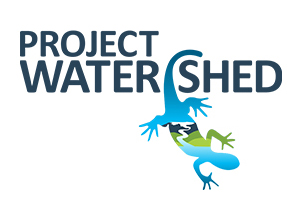[av_two_third first min_height=” vertical_alignment=” space=” custom_margin=” margin=’0px’ padding=’0px’ border=” border_color=” radius=’0px’ background_color=” src=” background_position=’top left’ background_repeat=’no-repeat’ animation=” mobile_display=”]
[av_textblock size=” font_color=” color=” admin_preview_bg=”]
Last year Project Watershed completed major habitat work in Simms Millennium Park in order to enhance the area for fish and wildlife. The project involved the installation of two new large culverts to create a flow through channel and streamside (riparian) plantings. This spring and summer we have been back in order to assess how the channel is working; in particular, we wanted to see how it held up after the heavy winter storm events. The channel is functioning as expected, and over wintered well with no major issues. There were a few areas of bare earth noted around one culvert and recently we returned to the park to fill in these areas with some additional rock. Some other large rock and large woody debris were placed in the channel at the same time to add some more habitat features for fish.
[/av_textblock]
[av_image src=’https://projectwatershed.ca/wp-content/uploads/2018/08/Simms_Newsletter-1030×579.jpg’ attachment=’11957′ attachment_size=’large’ align=’center’ styling=” hover=” link=” target=” caption=” font_size=” appearance=” overlay_opacity=’0.4′ overlay_color=’#000000′ overlay_text_color=’#ffffff’ animation=’no-animation’ admin_preview_bg=”][/av_image]
[av_textblock size=” font_color=” color=” admin_preview_bg=”]
Simms sedge bench almost completely filled in with plants.
[/av_textblock]
[/av_two_third][av_one_third min_height=” vertical_alignment=” space=” custom_margin=” margin=’0px’ padding=’0px’ border=” border_color=” radius=’0px’ background_color=” src=” background_position=’top left’ background_repeat=’no-repeat’ animation=” mobile_display=”]
[av_image src=’https://projectwatershed.ca/wp-content/uploads/2018/08/P_20180830_100542_vHDR_On-579×1030.jpg’ attachment=’11951′ attachment_size=’large’ align=’center’ styling=” hover=” link=’lightbox’ target=” caption=” font_size=” appearance=” overlay_opacity=’0.4′ overlay_color=’#000000′ overlay_text_color=’#ffffff’ animation=’no-animation’ admin_preview_bg=”][/av_image]
[av_textblock size=” font_color=” color=” admin_preview_bg=”]
Photo of additional area of rock added (to right of culvert) to cover bare earth.
[/av_textblock]
[/av_one_third][av_hr class=’invisible’ height=’15’ shadow=’no-shadow’ position=’center’ custom_border=’av-border-thin’ custom_width=’50px’ custom_border_color=” custom_margin_top=’30px’ custom_margin_bottom=’30px’ icon_select=’yes’ custom_icon_color=” icon=’ue808′ font=’entypo-fontello’ admin_preview_bg=”]
[av_textblock size=” font_color=” color=” admin_preview_bg=”]
The plantings in the park were looking fantastic this past spring with around a 95% survival rate. But the long hot summer has taken its toll, and many of the plants are now stressed – although mulching around the base of the plants by City of Courtenay Parks staff has certainly helped many of these fair better than they would have otherwise. However, the lower sedge benches that were created as part of the project and planted with Slough sedge, have done fantastic, and are looking quite lush. In the coming years Project Watershed will continue to monitor fish usage and water quality at the site, and we’ll be back next spring see how many of our plants survive once they get some much needed winter rain!
[/av_textblock]
Working with the K’ómoks Nation towards Q’waq’wala7owkw on their unceded territory.

